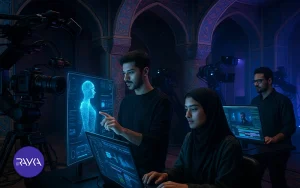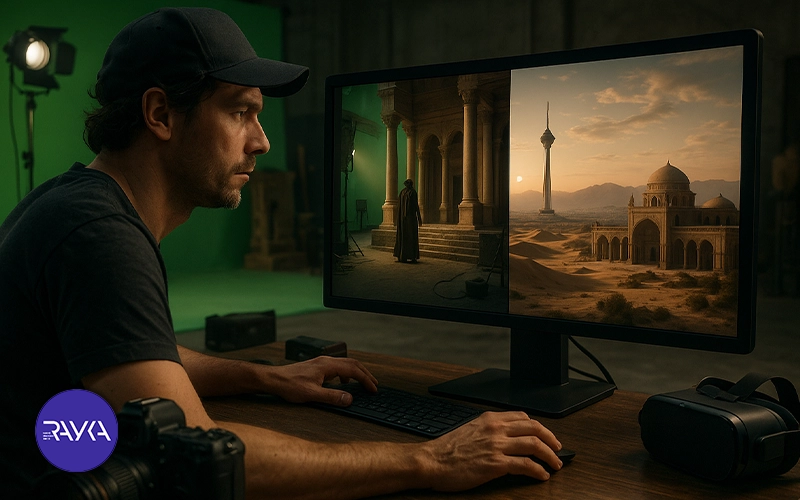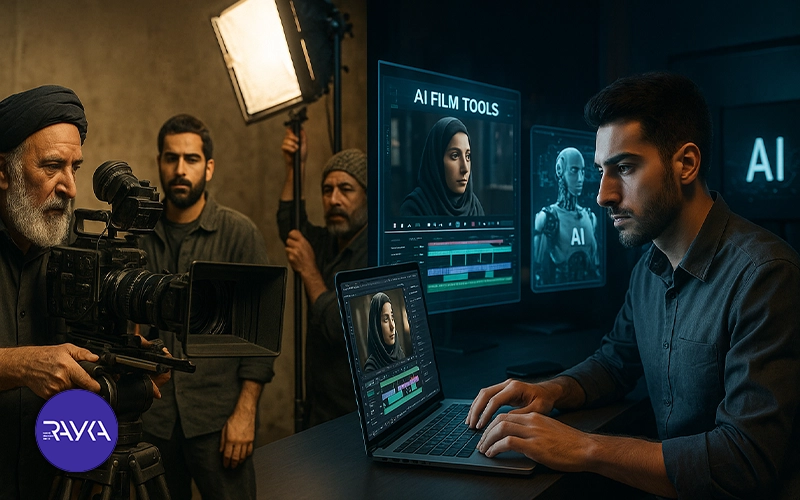
The future of AI filmmaking in Iran shows that this technology has the potential to transform the boundaries of creativity, speed, and production quality. Artificial intelligence enables filmmakers to manage pre-production, production, and post-production with greater accuracy and lower costs. Despite technological restrictions and sanctions, Iran is gradually adopting AI in cinema, a trend that can pave the way for innovative and competitive works both domestically and internationally.
Exploring the benefits of AI in film production and its impact on quality, time, and cost helps define the future of AI filmmaking in Iran.
AI-generated environments significantly lower production costs.
With artificial intelligence, filmmakers can digitally recreate real locations and settings. This reduces the need for travel, set construction, and location rentals, making it possible to design diverse scenes in a shorter time frame.
AI can simulate actors in challenging or costly scenes.
Artificial intelligence allows for the creation of digital actors in dangerous, complex, or expensive scenarios. This not only increases the safety of production teams but also provides flexibility in designing scenes and making rapid changes to characters.
AI speeds up editing and audio post-production with precision.
Intelligent systems can automatically edit scenes, synchronize sound, and generate music tailored to the film’s mood. This accelerates production while enhancing the final quality.
AI shortens the overall filmmaking timeline.
From pre-production to post-production, artificial intelligence handles many time-consuming tasks. This allows projects to be completed faster and enables creative teams to focus more on content and artistic quality.
The entry of artificial intelligence into Iranian cinema is reshaping professional roles while creating new opportunities in technology-driven filmmaking.
While some traditional roles may decline, new specialized positions will emerge, offering filmmakers and tech experts the chance to work in innovative fields.
The future of AI filmmaking in Iran will combine traditional skills with digital innovation. New job opportunities include:

Examining differences in quality, cost, and production time between traditional filmmaking and AI-driven filmmaking.
Artificial intelligence has streamlined complex production processes, enabling filmmakers to create with greater speed and precision. The main advantages include:
Despite its many advantages, AI may reduce human creativity and create over-reliance on technology. Filmmakers should be mindful of these challenges:
Artificial intelligence is set to revolutionize film production, impacting quality, costs, and speed across all stages. Key areas of transformation include:
AI enhances visual effects, making them more realistic.
It can generate complex, high-detail CGI scenes digitally without the need for heavy equipment or physical sets, greatly boosting the visual quality of films.

Artificial intelligence is increasingly positioned as a powerful replacement for traditional CGI, offering faster and more cost-effective solutions for creating immersive visuals.
| Feature | Traditional Filmmaking | AI Filmmaking |
|---|---|---|
| Production time | Long and time-consuming | Shorter and faster |
| Cost | High due to locations and equipment | Significant cost reduction with digital environments |
| Quality of effects | Medium to high depending on the team’s skills | High and realistic with AI precision |
| Flexibility in locations | Limited to physical sets and real environments | Unlimited with digital scenes and environments |
| Editing and sound design speed | Manual and time-consuming | Automated and fast with AI |
Artificial intelligence can transform every cinematic genre and elevate the quality of film production.
From action and drama to animation and documentary, AI brings unique advantages to each style, helping filmmakers push creative boundaries while producing scenes with higher quality in less time. The impacts of AI on different genres include:
Showcasing AI’s power in creating thrilling and terrifying scenes.
Rayka Mah has produced a cinematic zombie trailer using AI, delivering highly realistic visual effects and intense action. The project successfully conveys fear and excitement, highlighting the capability of AI in crafting immersive horror experiences.
Blending human creativity with AI for compelling storytelling.
Rayka Mah produced the short film “Two Hearts, Two Lands” with the help of AI. The film presents an engaging narrative and stunning visual sequences, proving that combining human creativity with AI can elevate both the quality and originality of cinematic works.
AI is reshaping certain roles, but human creativity remains indispensable.
The rise of AI in filmmaking is altering professional roles, but it does not completely replace humans. Many jobs will continue through a fusion of human skills and AI technology, while new career paths will emerge in specialized areas. Creativity, experience, and human decision-making remain crucial for film success, meaning AI transforms—but does not endanger—the future of filmmaking careers.
The future of AI-driven filmmaking in Iran shows that this technology has made production faster, more cost-efficient, and more innovative. From visual effects to editing and sound design, AI provides filmmakers with powerful tools to create high-quality, engaging works. However, human creativity and experience remain central. The best path forward for Iran’s film industry lies in the synergy between AI and human talent.